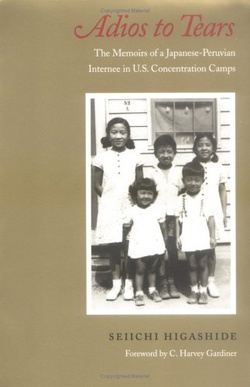Adios to Tears is the remarkable story of a Japanese immigrant to Peru who lost his home and business and joined thousands of other innocent Japanese immigrants in Central and South America who ended up interned in American concentration camps during World War Two.
What makes this autobiography, Adios to Tears: The Memoirs of a Japanese-Peruvian Internee in U.S. Concentration Camps by Seiichi Higashide (1909-1997) such a compelling read is that it traces the determined journey of his life from Hokkaido, Tokyo, then on to Peru, U.S. concentration camps during World War Two, then Chicago and Hawaii where he eventually retired.
The Higashide family is originally from Torikoshi Village, Ishikawa ken. Seiiichi’s mother, Yonu (nee Itakura) and father, Iwamatsu, were married in Torikoshi when the family was still prosperous. Then, as many family stories go, their fortune was squandered by the grandfather so the family had to move to Hokkaido in the early 1900s. They settled in Otoemura, Sorachi district, where Seiichi was born on January 18, 1909. The hard life of struggle to survive in a cold, hostile climate hardened Seiichi for the trials and tribulations that lay ahead of him.
The picture of life that he paints is a stark, vivid one that gives some insight in to the life in Japan that many of our forefathers left behind.
He gives us some colourful glimpses of life in Otoe: “The native Ainu people who lived in our village wore tonged slippers made from the cured skin of the salmon, but we settlers ate the salmon skin…. One of my mother’s special dishes was pressed sushi made with salted salmon.”
Higashide was a bright, imaginative student who was looking for opportunity outside of Japan. At the time, the United States was the main destination for Japanese immigrants, next was Peru. “Most Japanese who had crossed over to Peru had done so as agricultural workers, but later moved to urban areas to build successful commercial enterprises. In that sense, at that time, the Peruvian Japanese community was even more advanced than the Japanese immigrants in North American who were still based mainly in agricultural activities.”
He was also enticed by the success story of architect Shintaro Tominaga, an outstanding leader of the Nikkei community in Peru who constructed the Presidential Palace in the early 1920s.
Higashide’s own rise to success in Peru was a quick one. He started out as a teacher at the Japanese Language School, then, impressing local businessman, Choichi Otani, by his “upbringing and personality” was given the opportunity to take over his business when he wanted to retire and return to Japan.
In 1939, unfounded rumours circulated that the Japanese in Peru had formed a “fifth column” and built a military base in Peru. Higashide infers that there was American sponsorship of these rumours as many South American countries were then leaning more towards Axis countries.
Following Japan’s attack on Pearl Harbour, prominent Japanese leaders, including Higashide, were put on to a “blacklist.” After hiding out in a space that he dug out underneath his home, he was eventually caught, imprisoned and put on board a ship bound for prison in the United States.
While on board he had plenty of time to contemplate his fate. “From the time I was a child I had read many books about America. I had felt that America was an ideal country that should be taken as a model for the whole world… Where was the spirit of individual rights and justice that filled the Declaration of Independence and the US Constitution? If I termed Peru, even provisionally, a ‘third rate country,’ was not America, in this instance, no different?”
Higashide was first imprisoned in “Camp Kenedy” (sic), a Texas prison for single men. He was later joined by his family in June 1944 at Crystal City internment camp.
It is little known that 2,118 innocent Japanese had been deported to the United States from 12 Central and South American countries. Of these, 1,024 were arrested by their countries of residence and deported to internment camps in the U.S. The remaining number represents family members who ‘voluntarily’ joined their fathers in prison. After the war, the Peruvian government rejected the U.S. request to accept all of the internees back into the country. Only in 1946 did they allow the reentry of 79 who had Peruvian citizenship and their families. The remaining ones had no “home” to return to.
The Higashides were eventually granted “restricted parole” in August 1946. Seabrook Farms in New Jersey agreed to be the family’s sponsor. In 1949 the family was able to leave and pursue their own life in Chicago where earlier Nikkei settlers helped the family of eight to start over yet again.
What follows is a Horatio Alger story that is as American as apple pie. The family worked hard, persevered and eventually enjoyed the success of seeing their children enter university and becoming successes. Higashide and his wife eventually ended up retiring in Hawaii.
Finally, it is important to point out that the Redress struggle continues to this day for many Latin American Nikkei and their descendants. (For more information about the Japanese Latin American cause go to www.campaignforjusticejla.org.)
Despite the travails of such an ill-fated life in so many ways, Higashide’s is ultimately one of triumph over circumstances and victory over racism.
Adios To Tears, Seiichi Higashide, University of Washington Press, 2000.
© 2011 Norm Ibuki






